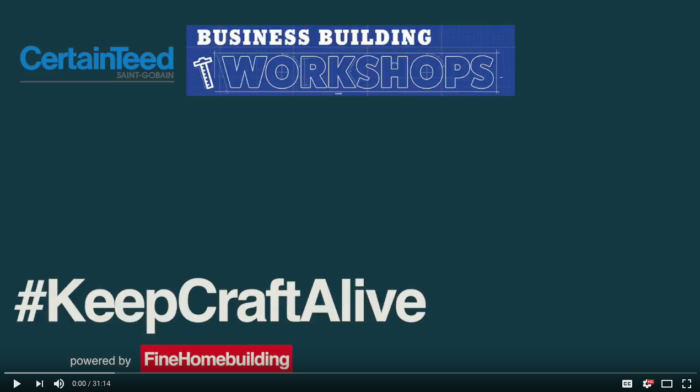Solving the Skills Gap
The construction industry not only suffers from the physical gap created by the lack of people entering the trades but also a cultural gap has been growing because of the way in which society views the trades.

The Skills Gap, that is, the lack of available skilled labor in the United States, is a real problem for every construction business. There simply aren’t enough people pursuing a career in the trades and obtaining the necessary skills needed to fill the vacancies created by the recession and an aging workforce.
The construction industry not only suffers from the physical gap created by the lack of people entering the trades but also a cultural gap has been growing because of the way in which society views the trades.
We (professionals in the trades) can solve this problem if we do this one thing:
IGNITE A REVIVAL IN THE TRADES
I recently gave the keynote addresses at the Certainteed Business Building Workshops in Atlantic City, NJ and Washington D.C.
In these keynotes I had the honor of representing Fine Homebuilding and informing the audiences about the Keep Craft Alive movement and how Fine Homebuilding was working to do their part in solving the skills gap.
CLICK HERE TO WATCH THE ENTIRE KEYNOTE
SOLVING THE SKILLS GAP
Fine Homebuilding is working on implementing a 3-part solution to solve the skills gap in the United States.
STEP ONE – IDENTIFY THE PROBLEM
The Skills Gap is growing wide (physical gap) because the number of people that have left (recession) or are leaving (retirement) are greater than the number of people entering the workforce.
The Skills Gap is also growing deeper (cultural gap) because younger generations are not being encourage to pursue a career in the trades. Society looks down on the trades as a lucrative and worthwhile career path.
The physical gap is a numbers game. It’s simply math. There aren’t enough people entering the skill trades to balance the number of people leaving or that have left the industry.
The physical gap is amplified by the cultural gap. Society looks down on the trades and younger generations aren’t being encouraged to pursue a career in the trades.
During the keynotes I dispelled some common myths that surround what society views as the path to a “good job” and the realities of what a “good job” is today.
Click here to see the myths surround the definition of a “good job.”
STEP TWO – INFORM THE PUBLIC
Informing the public of the investment required to pursue a college degree or a trade school certification is one way to change the way society views the trades.
Click here to see the average investment required for both options.
Fine Homebuilding has partnered with Certainteed to provide scholarships to SkillsUSA for students pursuing a career in construction related fields.
It is Fine Homebuilding’s hope that informing the public of the investment required and the educational opportunities available through organizations like SkillsUSA and other trade schools will open new opportunities for high school and college-aged students to pursue career training in the trades.
STEP THREE – INSPIRE OTHERS
The final step in solving the Skills Gap problem is to inspire others to pursue a career in the trades. This can be accomplished only if existing construction professionals create opportunities for advancement within their businesses for a younger generation of workers.
CALL TO ACTION
When people know where they’re going and how to get there then they’re going to feel accomplished along the way. They’ll take that sense of accomplishment home with them and that will inspire hope in their communities and in their families.
You ask,
“What can I do?”
You can provide hope because hope is contagious.
You are the spark. Whether you’re the owner, the manager or the employee, the way in which you perform your job and put your craft on display for the world to see, that is the fuel that will ignite a revival in the trades.
Igniting a revival in the trades is the solution to the skills gap.
And I encourage you to do your part in this movement to #KeepCraftAlive.
…
Thanks for taking the time to read this article. I really appreciate and value your time. Please leave a comment below and let me know if you agree, disagree, or have any questions about this topic.
Follow me on YouTube, Instagram @shawnvandyke, LinkedIn, Facebook, or shawnvandyke.com to learn more about how to streamline your construction business.





























View Comments
Good work! Thank you.
OK - so all-hands-on-deck.
Identify the problem - Check
Inform the public - Check
Inspire others - Check
Ok, so now we need some actionable specifics. Nuts and bolts stuff. What can I do?
Let's get beyond the 'talk to people' 'jump on social media' That's easy stuff but hard to see results. I'm not impressed by 'impressions.'
What can a tradesperson at the swinging a hammer, crimping tubing or pulling cable level do to have an impact?
How can a tradesperson get involved in making a concrete difference?
Talk is cheap and doesn't feel impactful.
We work with our hands, minds and hearts. We stand back every day and see results from our actions.
List out 10 things that a tradesperson can do to recruit people into the trades and train them. List out things that we can do; things that will get results; things that we can touch, feel, see at the end of the day.
Thanks
Very worthwhile information. I'm sure I'm not the only one who did get a degree and then spend many years in the trades. I was good at academics, but I could never find a job that was as satisfying as design and build, and no small part of this was just the physical engagement and camaraderie. I'm retired now, and I don't know if a job in the trades would be the same since the technology has changed so much. But I think it will always be a challenge, and mastering skills that have real-world applications is still an achievement that gives a confidence that's hard to find in a digital world.
It's not a "skills" gap. It's a pay gap. Everyone wants journeyman work. When they realize that it's going to cost more than $15/hr., they decide that a starving tweaker will do an adequate job. No one in his right mind is going to sweat in the sun, lift heavy objects and risk grievous bodily harm every day for a subsistence wage. They're going to get an office job. The mere fact that people keep calling it a "skills" gap indicates the unwillingness to address the root problem.
If you want good work, then pay for it.
In California if it was not for the people born in Mexico who moved here, there would be no skilled tradespeople outside of the electricians (who have a union that trains newbies). In 2008 with the bank crash most construction firms either went out of business or cut back to a single crew that the owner could supervise.
Costs of worker's comp insurance and medical insurance are a major impediment to small contractors hiring more workers. Single payer healthcare as is provided in every other first world country would be an enormous help.
At this time there is such a dearth of skilled master carpenters and plumbers that there is no one to train the trainee. Community colleges can help but they are focused on other industries and that is the fault of the construction business community.
Another big problem is the cost of housing that increases year after year while wages are at 1970 levels. A master carpenter cannot afford to rent a 3 bedroom house of any kind and have money for their truck and food for their family, much less for medical care.
We have come to resemble a banana republic with the super rich and the very poor and this squeezes out the skilled workers in all but the most affluent areas.